Upload your photos and videos
Pictures | Google imagePterois cincta
Picture by Bogorodsky, S.V.
Pictures | Google imagePterois cincta
Picture by Bogorodsky, S.V.
Common names from other countries
Classification / Names Nombres comunes | Sinónimos | Catalog of Fishes(Género, Especie) | ITIS | CoL | WoRMS | Cloffa
> Perciformes/Scorpaenoidei (Scorpionfishes) > Scorpaenidae (Scorpionfishes or rockfishes) > Pteroinae
Etymology: Pterois: Greek, pteron = wing, fin (Ref. 45335).
Etymology: Pterois: Greek, pteron = wing, fin (Ref. 45335).
Environment: milieu / climate zone / depth range / distribution range Ecología
marino asociado a arrecife; rango de profundidad 5 - 15 m (Ref. 123589). Tropical
Distribución Países | Áreas FAO | Ecosistemas | Ocurrencias, apariciones | Point map | Introducciones | Faunafri
Western Indian Ocean: restricted to the Red Sea.
Tamaño / Peso / Age
Short description Claves de identificación | Morfología | Morfometría
Espinas dorsales (total) : 12; Radios blandos dorsales (total) : 10 - 12; Espinas anales: 3; Radios blandos anales: 6 - 7. This species is distinguished from its congeners by the following set of characters: usually D XII,11 (rarely XII,10 or XII,12) and pectoral-fin rays 16 (rarely 15, 17 or 18); scale rows in longitudinal series 51-57; dorsal-fin soft rays relatively long with longest ray length 30.9-40.5 (mean 35.8) % of SL; anal-fin soft rays relatively long with longest ray length 35.8-44.8 (40.4) % of SL; pectoralfin rays relatively long, the ninth with length 75.6-113.2 (92.4) % of SL; pelvic-fin soft rays relatively long with longest ray length 48.2-71.9 (60.0) % of SL, its posterior tip reaching or extending beyond vertical through posteriormost anal-fin soft ray base when depressed; supraocular tentacle with no lateral branches; postorbital sensory canal absent or is not connected to sphenotic spine base at any life history stage. Colouration: body sides with five broad dark black bands, plus a single horizontal broad dark band on caudal peduncle, the fourth and fifth body bands relatively narrow, dorsal width 5.8-9.3 (mean 7.4) % of SL and 3.4-9.3 (7.3) % of SL, respectively; fourth additional (inserted) marking relatively broad, dorsal width 2.1-4.9 (3.6) % of SL (Ref. 123589).
Inhabits sandy bottom of coral reefs (Ref. 123589).
Life cycle and mating behavior Madurez | Reproducción | Puesta | Huevos | Fecundidad | Larva
Main reference
Upload your references | Referencias | Coordinador | Colaboradores
Matsunuma, M. and H. Motomura, 2015. Redescriptions of Pterois radiata and Pterois cincta (Scorpaenidae: Pteroinae) with notes on geographic morphological variations in P. radiata. Ichthyol. Res. 63(1):145-172. (Ref. 123589)
Threat to humans
Harmless
Human uses
Pesquerías: de interés potencial
FAO(Publication : search) | FishSource |
Más información
Trophic ecology
componentes alimenticios
Composición de la dieta
consumo de alimento
Food rations
Despredadores
componentes alimenticios
Composición de la dieta
consumo de alimento
Food rations
Despredadores
Ecology
Ecología
Home ranges
Ecología
Home ranges
Population dynamics
Coeficiente del crecimiento para
Max. ages / sizes
Length-weight rel.
Length-length rel.
Length-frequencies
Mass conversion
Reclutamiento
Abundancia
Coeficiente del crecimiento para
Max. ages / sizes
Length-weight rel.
Length-length rel.
Length-frequencies
Mass conversion
Reclutamiento
Abundancia
Life cycle
Reproducción
Madurez
Fecundidad
Puesta
Spawning aggregations
Huevos
Egg development
Larva
Dinámica larvaria
Reproducción
Madurez
Fecundidad
Puesta
Spawning aggregations
Huevos
Egg development
Larva
Dinámica larvaria
Anatomy
Superficie branquial
Brain
Otolith
Superficie branquial
Brain
Otolith
Physiology
Body composition
Nutrients
Consumo del oxígeno
Tipo de natación
Velocidad de natación
Visual pigments
Fish sound
Diseases & Parasites
Toxicity (LC50s)
Body composition
Nutrients
Consumo del oxígeno
Tipo de natación
Velocidad de natación
Visual pigments
Fish sound
Diseases & Parasites
Toxicity (LC50s)
Genetics
Genética
Heterozygosity
heritabilidad
Genética
Heterozygosity
heritabilidad
Human related
Aquaculture systems
Perfiles de acuicultura
Razas
Ciguatera cases
Stamps, coins, misc.
Aquaculture systems
Perfiles de acuicultura
Razas
Ciguatera cases
Stamps, coins, misc.
Herramientas
E-book | Guía de campo | Asistente para frecuencias de tallas | Herramienta de ciclo de vida | Mapa de puntos | Classification Tree
| Catch-MSY |
Special reports
Download XML
Fuentes de Internet
Aquatic Commons | BHL | Cloffa | Websites from users | Check FishWatcher | CISTI | Catalog of Fishes(Género, Especie) | DiscoverLife | ECOTOX | Faunafri | Fishtrace | GenBank(genome, nucleotide) | GloBI | GOBASE | | Google Books | Google Scholar | Google | IGFA World Record | MitoFish | Otolith Atlas of Taiwan Fishes | PubMed | Reef Life Survey | Scirus | SeaLifeBase | Árbol de la vida | Wikipedia(Go, búsqueda) | World Records Freshwater Fishing | Zoobank | Expediente Zoológico
Estimates based on models
Phylogenetic diversity index (Ref. 82804): PD50 = No PD50 data [Uniqueness, from 0.5 = low to 2.0 = high].
Bayesian length-weight: a=0.01000 (0.00440 - 0.02274), b=3.02 (2.83 - 3.21), in cm Total Length, based on LWR estimates for this (Sub)family-body shape (Ref. 93245).
Nivel trófico (Ref. 69278): 3.8 ±0.6 se; based on size and trophs of closest relatives
Resiliencia (Ref. 120179): Medio, población duplicada en un tiempo mínimo de 1.4-4.4 años (Preliminary K or Fecundity.).
Fishing Vulnerability (Ref. 59153): Low vulnerability (10 of 100).




